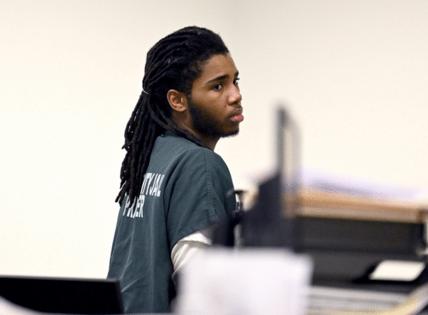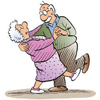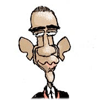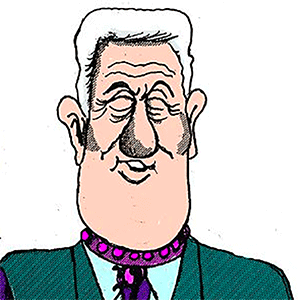Judge says there is 'ample evidence' man caused Detroit mass shooting, largest in state history
Published in News & Features
DETROIT — The man accused of causing the largest mass shooting in Michigan history in 2024 in Detroit will stand trial on 36 felonies, including first-degree murder, attempted murder and felony firearm.
District Court Judge Shawn Jacque with Detroit's 36th District Court on Monday found there was enough evidence for Demitrus Shaw to go to trial on charges that accuse him of killing two people and injuring 16 others at a July 7 block party in Detroit. Three other people were injured in the shooting, but prosecutors dismissed the charges after they could not offer testimony showing they were shot.
Shaw, 19, said during his eight-hour interrogation with Detroit police and Michigan State Police that he and five other people went to a block party on Rossini Drive in Detroit to conduct a shooting in retaliation for another shooting a year prior. It stemmed from disputes between two gangs, Michigan State Police Sgt. Michael Klenner testified.
Jacque said there is “ample evidence” of probable cause that Shaw committed the crimes he is charged with.
Despite Shaw only admitting to firing two shots before someone else took the gun from him, Wayne County Assistant Prosecutor Natayai Scott said prosecutors do not have to prove that Shaw's bullets struck the victims for him to be guilty of attempted murder and murder.
"The people maintain he is the principal. He was the driver of the vehicle taking these people to the scene to commit murder and attempted murder," Scott said. "When he shot into that crowd, every single person that was in the line of fire, became a victim, whether or not they were hit."
Shaw is the only person charged in the attack. He gave police the names of four or five other people who were with him, but none have been charged so far. Prosecutors said the case remains under investigation.
Shaw's attorney, Mohammed Nasser, said he respects Jacque's decision, even though he disagrees with it. During his closing argument, Nasser said "zero" witnesses put his client at the scene.
"Zero witnesses showing my client doing any shootings," he said. "... What you have here is an alleged admission of two shots. Two shots does not articulate into 37 (sic) counts that are bound over today."
Nearly all the evidence connecting Shaw to the shooting came from his interrogation, which Nasser tried and failed to have quashed. Nasser said police should have reread Shaw his Miranda rights — his rights to remain silent and to have an attorney — at several points during the interrogation, but Jacque said there were not adequate findings that Shaw's confession was involuntary.
Nasser also argued that police should not have lied to Shaw during the interrogation, making him believe the evidence they had against him was better than it was. Scott said police do have the right to lie to defendants during interrogations.
Nasser said Detroit Police Officer Sgt. Reginald Beasley used “racial coercion” to try to get Shaw to talk when Beasley told Shaw that people from Detroit rip up jury summons, and that he may be tried by a jury of white people instead of people who “look like” him.
"I believe that statement, taken under the totality of the circumstances, would show a complete lack of empathy as it relates to Miranda, and more importantly, using racially biased terms in order to coerce an alleged admission," Nasser said.
But Jacque said that statement could be interpreted as Beasley’s opinion, and that he did not find it to be “so offensive and so overwhelming that they would overwhelm the defendant and cause him to make an involuntary statement."
Klenner testified that police recovered shell casings connected to two other shootings Shaw was alleged to have been involved in, including a drive-by shooting in Detroit. This was what led them to Shaw as a suspect, Klenner said. He did not offer details on ballistics, and prosecutors did not ask him about them.
In all, 14 witnesses testified, eight of whom were victims of the shooting. None of the victims said they saw who shot them, though two women said they believed there was more than one shooter.
Shanae Fletcher, 20, of Harrison Township and Phillip Arnold, 21, of Detroit, were killed July 7 at the large block party on Rossini Street in Detroit.
Klenner testified that Shaw and his family are members of the 55 gang, an associate of the Los Angeles gang the Bloods. The area of Rossini where the block party took place is known to be a Bloods area, Klenner said, but the party was hosted by the Crips, a rival gang.
In an interrogation video played in court, Shaw shared with Beasley what he was thinking before the shooting.
“I had second thoughts. Once everyone got out it was just that,” Shaw told Beasley in the video. “I was telling them this ain’t a good idea, but it’s like 'we’re already here.'”
Shaw said he was just “following wherever they’re going," referring to the other people he was with.
Klenner said police have video of three shooters lining up on the side of a car parked in a driveway, then beginning to shoot. None of the people in the video are identifiable, Klenner said. Police believe there were three other shooters as well, as Shaw told them the others went down another driveway.
Shaw claimed he only fired twice, and that someone else then took his gun.
"They was really mad at me because I only let off two shots and I ran," Shaw said.
Both Klenner and Beasley said they have videos of the shooters, but said they were unable to identify who they were. They could not even tell their race or sex, Beasley said.
None of the eight victims who testified during Shaw's preliminary exam said they saw who shot them, instead describing a chaotic scene with too many gunshots to count.
Shaw is also charged with the May 31 nonfatal shooting of a 37-year-old Detroit man on Collingham Drive in Detroit.
_____
©2025 The Detroit News. Visit detroitnews.com. Distributed by Tribune Content Agency, LLC.







Comments